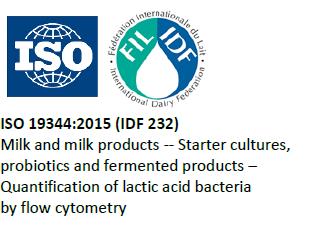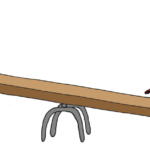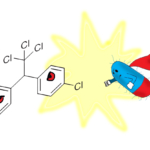Alive or active? Active and alive! Flow cytometry has arrived.
November 8, 2016. By Bruno Pot, PhD, Vrije Universiteit Brussels, Belgium –
Probiotics need to be alive and confer health benefits for the host (Hill et al. 2014; FAO/WHO 2001). There are no further specifications as to the mechanisms underpinning these health effects. A large number of papers currently describe the wide diversity of the probiotic mechanisms, varying from the production of specific metabolites (see references 1-6, below), the presence of cell wall compounds (7-10) or the production of specific proteins (11), and covering a wide variety of possible probiotic or commensal bacteria.
While many of these mechanisms require the bacteria to be active at the site of action, they rarely require the bacteria to actively multiply. This observation has triggered the notion ‘active’ in addition to ‘alive’. While it is clear that active bacteria are alive, and therefore in agreement with the consensus definition of probiotics, the problem lies in the difficulties of counting active cells that are not multiplying. The latter will, obviously, not give rise to colonies, excluding traditional colony counting methods for their enumeration. In contrast, approaches like 16S-rRNA based PCR (quantitative or qualitative) will detect dead bacteria, which we do not want to count.
While validation of microbiological methods is difficult for many reasons (see here) flow cytometry technologies offer very interesting perspectives in detecting active bacteria. The technology has been used for a long time for analyzing subpopulations of bacteria in probiotic products or dairy starters (12). Moreover, flow cytometry was known to be able to discriminate between viable and dead cells also for nearly 25 years (13). While also the validation approaches for microbiological methods were known, it was not until January 2016 that the method, through a joint effort of ISO and International Dairy Federation, was formally validated, resulting in the ISO 19344 (IDF 232) standard. This standard now provides a flow cytometry-based method to quantify lactic acid bacteria in fermented products, starter cultures and dairy probiotics. Besides being able to discriminate between- and quantify- active and total cells, flow cytometry has other advantages such as high testing speed and low variability. Therefore the method is very useful during production and shelf life follow up.
Flow cytometry is also promising for fundamental research in the field of probiotics as well as in the evaluation of microbiological parameters in clinical trials with these products. It will be useful to quickly to count active bacteria or to measure a differential count between active and colony forming bacteria. Further, probiotic producers may be especially interested in the method as the colony count method likely underestimates the number of live bacteria in their products.
Will we start to see probiotic labels where CFU is replaced by ‘numbers of active bacteria’? Probably not anytime soon. The idea of detecting and counting ‘active’ bacteria is here to stay, but the use of that information on a label seems unlikely in the near future, as the notion ‘active’ versus ‘alive’ does not really change the way probiotics exert their beneficial activity. The positive point of the new method is that it potentially allows a much more precise determination of the probiotic in the product, positively drawing industries’ attention to the number of bacteria, definitely an important aspect of the probiotic definition.
References:
- Elise Heuvelin, Corinne Lebreton, Corinne Grangette, Bruno Pot, Nadine Cerf-Bensussan, Martine Heyman. Mechanisms Involved in Alleviation of Intestinal Inflammation by Bifidobacterium Breve Soluble Factors. PLOS. 2009 ; http://dx.doi.org/10.1371/journal.pone.0005184)
- Elise Heuvelin, Corinne Lebreton , Maurice Bichara, Nadine Cerf-Bensussan and Martine Heyman. A Bifidobacterium Probiotic Strain and Its Soluble Factors Alleviate Chloride Secretion by Human Intestinal Epithelial Cells. J. Nutr. 2010; 140 (1):7-11. (http://jn.nutrition.org/content/140/1/7)
- Sokol H, Pigneur B, Watterlot L, Lakhdari O, Bermúdez-Humarán LG, Gratadoux JJ, Blugeon S, Bridonneau C, Furet JP, Corthier G, Grangette C, Vasquez N, Pochart P, Trugnan G, Thomas G, Blottière HM, Doré J, Marteau P, Seksik P, Langella P. Faecalibacterium prausnitzii is an anti-inflammatory commensal bacterium identified by gut microbiota analysis of Crohn disease patients ; Proc Natl Acad Sci USA. 2008 Oct 28;105(43):16731-6. doi: 10.1073/pnas.0804812105. Epub 2008 Oct 20.
- E Quévrain, M A Maubert, C Michon, F Chain, R Marquant, J Tailhades, S Miquel, L Carlier, L G Bermúdez-Humarán, B Pigneur, O Lequin, P Kharrat, G Thomas, D Rainteau, C Aubry, N Breyner, C Afonso, S Lavielle, J-P Grill, G Chassaing, J M Chatel, G Trugnan, R Xavier, P Langella, H Sokol, P Seksik. Identification of an anti-inflammatory protein from Faecalibacterium prausnitzii, a commensal bacterium deficient in Crohn’s disease. Gut 2014; doi:10.1136/gutjnl-2014-307649.
- Ghalia Kacia, Denise Goudercourt, Véronique Denninc, Bruno Pot, Joël Doré, S. Dusko Ehrlicha, Pierre Renault, Hervé M. Blottière, Catherine Danielc,d,e,f and Christine Delorme. Anti-Inflammatory Properties of Streptococcus salivarius, a Commensal Bacterium of the Oral Cavity and Digestive Tract. Appl. Environ. Microbiol. 2014; 80(3): 928-934.
- Carissa M. Thomas, Teresa Hong, Jan Peter van Pijkeren, Peera Hemarajata, Dan V. Trinh, Weidong Hu, Robert A. Britton, Markus Kalkum, James Versalovic. Histamine Derived from Probiotic Lactobacillus reuteri Suppresses TNF via Modulation of PKA and ERK Signaling. PLOSone http://dx.doi.org/10.1371/journal.pone.0031951.
- Corinne Grangette, Sophie Nutten, Emmanuelle Palumbo, Siegfried Morath, Corinna Hermann, Joelle Dewulf, Bruno Pot, Thomas Hartung, Pascal Hols and Annick Mercenier. Enhanced anti-inflammatory capacity of a Lactobacillus plantarum mutant synthesizing modified teichoic acids. PNAS. 2005. 102(29):10321–10326, doi: 10.1073/pnas.0504084102
- Macho Fernandez E1, Valenti V, Rockel C, Hermann C, Pot B, Boneca IG, Grangette C. Anti-inflammatory capacity of selected lactobacilli in experimental colitis is driven by NOD2-mediated recognition of a specific peptidoglycan-derived muropeptide. 2011. Gut. 2011 Aug;60(8):1050-9. doi: 10.1136/gut.2010.232918. Epub 2011 Apr 6.
- Deutsch SM, Parayre S, Bouchoux A, Guyomarc’h F, Dewulf J, Dols-Lafargue M, Baglinière F, Cousin FJ, Falentin H, Jan G, Foligné B. Contribution of surface β-glucan polysaccharide to physicochemical and immunomodulatory properties of Propionibacterium freudenreichii. Appl Environ Microbiol. 2012 Mar;78(6):1765-75. doi: 10.1128/AEM.07027-11. Epub 2012 Jan 13.
- Foligné B., Deutsch S. M., Breton J., Cousin F.J., Dewulf J., Samson M., Pot B. and Jan G. (2010). Promising immunomodulatory effects of selected strains of dairy propionibacteria as evidenced in vitro and in vivo. Appl. Environ. Microbiol. 76:8259-8264.
- Fang Yan and D. Brent Polk. Characterization of a probiotic-derived soluble protein which reveals a mechanism of preventive and treatment effects of probiotics on intestinal inflammatory diseases. Gut Microbes. 2012 Jan 1; 3(1): 25–28. doi: 10.4161/gmic.19245.
- Christine J. Bunthof and Tjakko Abee. Development of a Flow Cytometric Method To Analyze Subpopulations of Bacteria in Probiotic Products and Dairy Starters. Appl Environ Microbiol. 2002 Jun; 68(6): 2934–2942 ; doi: 10.1128/AEM.68.6.2934-2942.2002
- J. P. Diaper, K. Tither, C. Edwards. Rapid assessment of bacterial viability by flow cytometry. 1992. Applied Microbiology and Biotechnology. Volume 38, Issue 2, pp 268–272.







